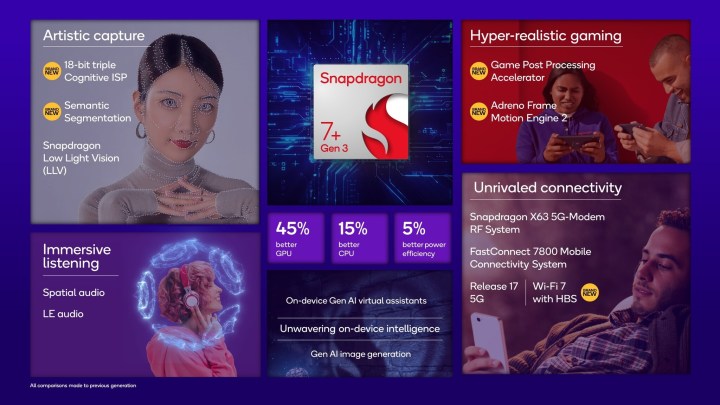
Qualcomm has introduced a new mid-tier smartphone silicon, the Snapdragon 7+ Gen 3, that will be adopted by the likes of OnePlus in the coming months. It seems like a minor upgrade over the Snapdragon 7 Gen 3, but the changes are actually quite comprehensive.
The company notes that for the first time in the Snapdragon 7 series, it is bringing generative AI features such as text-to-image creation, higher-resolution single-lens capture at up to 108-megapixels, a flagship-tier triple 18-bit ISP for image capture, and Wi-Fi 7 connectivity.
Qualcomm is touting a 15% jump in CPU performance and a healthy 45% increase in graphics firepower. Those upgrades come courtesy of the core-level tweaks put in place for this 4nm-based processor that offers faster cores across the entire prime, performance, and efficiency clusters.

The heavy-hitting prime core, which is based on Arm’s Cortex-X4 stack, runs at 2.8 GHz. Compared to three performance cores on its predecessor, the Snapdragon 7+ Gen 3 goes with four performance cores to get an edge. External display support also gets a healthy improvement, both in terms of resolution and refresh rate, reaching up to 8K resolution and variable refresh rates up to 240Hz.
Storage and memory capabilities get a sweet upgrade as well. The Snapdragon 7 Gen 3 was limited to UFS 3.1 storage and LP-DDR5 (3200 MHz) RAM, but the latest from Qualcomm makes the switch to faster UFS 4.0 storage and LP-DDR5x memory support (up to 4200 MHz).
The shift to an upgraded FastConnect 7800 platform also increases peak download speeds to 5.8 Gbps, a 2x gain compared to the Snapdragon 7 Gen 3. Wireless connectivity is refined and upgraded to the Bluetooth v5.4 standard.

The next-gen Image Signal Processor (18-bit triple ISP) opens the doors for slow-motion video capture at up to 240 frames per second (fps), double the peak frame rate of what its predecessor allowed. Pro Sight video capture, Snapdragon Low Light Vision (LLV), real-time semantic segmentation in photos and videos, and a second-gen video Bokeh Engine lead the other camera-centric capabilities.
Of course, on-device generative AI – thanks to support for large language models (LLMs) and large vision models (LVMs) – is a big part of the push here. Qualcomm is racing to catch up with MediaTek’s midrange Dimensity 8300 chip, which touts some really impressive generative AI chops and has been certified for Google’s Gemini AI model.
The latest offering from Qualcomm comes hot on the heels of Snapdragon 8s Gen 3, which borrows heavily from the flagship Snapdragon 8 Gen 3, but serves it all on a more affordable platter. Interestingly, the Snapdragon 8s Gen 3 has been confirmed for Xiaomi and Honor phones, while the Snapdragon 7+ Gen 3 is coming to a OnePlus phone — likely a new entry in the company’s Nord series.
It’s hard to say if/when a phone with either of these chips will make it to a U.S.-bound phone, but for the markets they are destined for, Qualcomm’s chip options for value flagships look better than ever.


